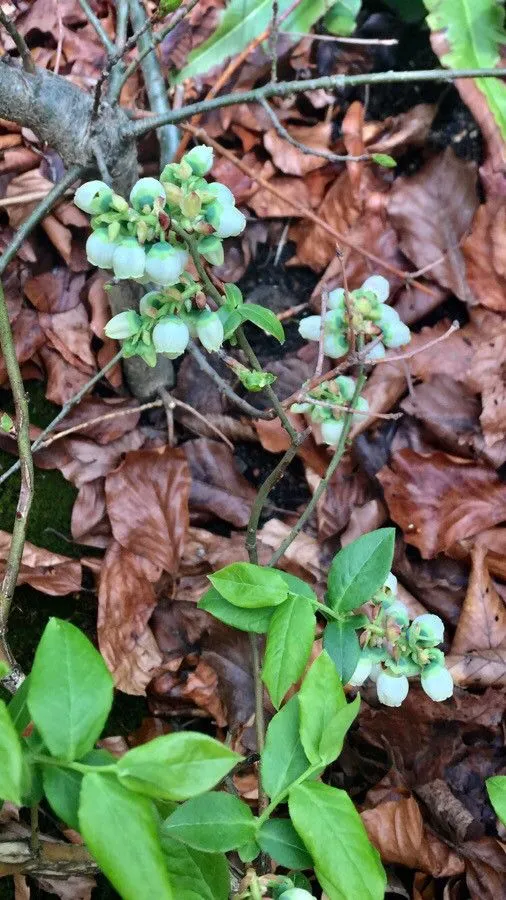
Author: L.
Bibliography: Sp. Pl.: 350 (1753)
Year: 1753
Status: accepted
Rank: species
Genus: Vaccinium
Vegetable: False
Observations: E. Canada to C. & E. U.S.A.
The American blueberry, scientifically known as Vaccinium corymbosum, is a fascinating plant belonging to the Ericaceae family. This fruit-bearing shrub has carved out an integral role in the flora of North America, thriving particularly from Eastern Canada down through Central and Eastern parts of the United States. Its comprehensive botanical reference dates back to the seminal work “Species Plantarum,” first described by Carl Linnaeus in 1753.
Native to a wide range of ecological niches, the American blueberry demonstrates remarkable adaptability. It flourishes in a variety of soils, provided they are acidic, well-drained, and rich in organic matter. Its natural preference is for environments that replicate the understory of forests where it can benefit from dappled sunlight and consistent moisture.
Characteristically, Vaccinium corymbosum boasts bell-shaped flowers that come in hues of white or pale pink, typically blooming in late spring to early summer. These flowers give rise to the plant’s namesake berries – juicy, blue fruits that are both delicious and nutritionally rich. Blueberries are often celebrated for their high antioxidant content, contributing significantly to human health by combating free radicals.
In addition to their edible value, these shrubs also play a crucial role in local ecosystems. They provide food and habitat for various wildlife species, from birds to small mammals. The dense foliage and berries attract pollinators like bees, which are essential for the plant’s reproductive cycle.
Cultivation of the American blueberry for commercial and personal use has surged owing to its health benefits and versatility. Whether enjoyed fresh, baked into pies, or processed into jams and jellies, blueberries remain a beloved component of diets and cuisines around the world.
Gardeners and farmers cultivating Vaccinium corymbosum should be mindful of its environmental requirements to ensure healthy growth and optimal berry production. This includes practices like mulching to retain soil moisture, proper fertilization to counteract nutrient deficiencies, and pruning to promote sunlight penetration and air circulation within the shrub canopy.
In summary, the American blueberry is more than just a fruit-bearing plant; it is a cornerstone of both horticulture and natural ecosystems within its native range. Its rich history, ecological importance, and nutritional value underscore the enduring allure of Vaccinium corymbosum.
Eng: american blueberry, blueberry, highbush blueberry, new jersey blueberry, smallflower blueberry, southern blueberry, swamp blueberry, highbush-blueberry, northern highbush blueberry, highbush huckleberry, tall blueberry
Deu: amerikanische blaubeere, amerikanische strauch-heidelbeere, amerikanische blueberry
Dan: amerikansk blåbær
Nld: trosbosbes
Fra: airelle d’amérique, bleuet cultivé, bluet en corymbe, bleuet en corymbe, airelle en corymbe, grande myrtille, myrtille américaine
Swe: amerikanskt blåbär
Spa: arándano americano
Por: mirtilo, mirtilo-highbush
Nob: hageblåbær
Nno: hageblåbær
Cym: llus america, llusen america
Gla: lus nan dearcag, lusan nan dearcag
En: American blueberry, Highbush blueberry, Blueberry, Swamp blueberry, High blueberry, Rabbiteye blueberry, Wild blueberry, New Jersey blueberry, Smallflower blueberry, Southern blueberry, Highbush-blueberry, Northern highbush blueberry, Highbush huckleberry, Tall blueberry
Af: Bloubessie
Ca: Nabiu blau
Zh: 北方高叢藍莓
Hr: Američka borovnica
Cs: Brusnice chocholičnatá
Da: Storfrugtet Blåbær, Amerikansk blåbær
Nl: Amerikaanse bosbes, Trosbosbes, Blauwe Bes
Eo: Blua bero
Fi: Pensasmustikka
Fr: Airelle d’Amérique, Bluet en corymbe, Airelle en corymbe, Bleuet en corymbes, Bleuet cultivé, Bleuet en corymbe, Grande myrtille, Myrtille américaine
Gl: Arandeira americana
De: Amerikanische Blueberry, Kulturheidelbeere, Amerikanische Blaubeere, Amerikanische Strauch-Heidelbeere, Amerikanische Strauchheidelbeere
It: Mirtillo americano
Lv: Augstās krūmmellenes
Lt: Aukštoji šilauogė
Nb: Hageblåbær
Nn: Hageblåbær
Pl: Borówka wysoka
Pt: Mirtilo, Mirtilo-highbush
Ru: Голубика высокорослая
Gd: Lus nan dearcag, Lusan nan dearcag
Sr: Sjeverna visokožbunasta borovnica
Es: Arándano americano
Sv: Amerikanskt blåbär
Vi: Việt quất xanh
Cy: Llusen America, Llus America
© copyright of the Board of Trustees of the Royal Botanic Gardens, Kew.
© copyright of the Board of Trustees of the Royal Botanic Gardens, Kew.
© copyright of the Board of Trustees of the Royal Botanic Gardens, Kew.
Taken Jul 25, 2021 by William Coville (cc-by-sa)
Taken Jul 27, 2021 by Bart Smet (cc-by-sa)
Taken Jul 27, 2021 by Bart Smet (cc-by-sa)
Taken Oct 14, 2021 by Francisco Caba (cc-by-sa)
Taken Oct 14, 2021 by Francisco Caba (cc-by-sa)
Taken Jul 25, 2021 by William Coville (cc-by-sa)
Taken Jul 27, 2021 by Bart Smet (cc-by-sa)
Taken Oct 14, 2021 by Francisco Caba (cc-by-sa)
Taken Oct 14, 2021 by Francisco Caba (cc-by-sa)
Taken Jul 17, 2020 by tre ania (cc-by-sa)
Taken May 12, 2019 by Инга (cc-by-sa)
Taken Apr 26, 2019 by Sinan Von Adel Knuplez (cc-by-sa)
Taken Mar 9, 2020 by Kram Navillus (cc-by-sa)
Taken May 18, 2018 by alltoomuch (cc-by-sa)
Taken May 1, 2020 by Sabina Hartmann (cc-by-sa)
Taken May 3, 2021 by Sabina Hartmann (cc-by-sa)
Taken Aug 2, 2022 by Szczepan Grzebinoga (cc-by-sa)
Taken Apr 24, 2020 by Sabina Hartmann (cc-by-sa)
Taken May 1, 2020 by Sabina Hartmann (cc-by-sa)
Taken May 4, 2021 by Dieter Wagner (cc-by-sa)
Taken Mar 13, 2015 by EOL − Michael Allen (cc-by-nc)
Taken Jun 1, 2013 by EOL − Kristen Norman (cc-by-nc)
Taken Jan 1, 1900 by EOL − John Hilty (cc-by-nc)
Taken May 31, 2020 by kimaluco17 (cc-by-sa)
Taken Aug 1, 2022 by Caja Karlberg (cc-by-sa)
Taken May 5, 2022 by Rosalie Cécile (cc-by-sa)
Taken Jul 15, 2014 by Photoflora – Jean-Luc TASSET (©)
Taken Nov 15, 2005 by Photoflora – Jean-Luc TASSET (©)
Taken Oct 29, 2020 by Nick PHELPS (cc-by-sa)
Taken Nov 6, 2022 by Karen Yallico (cc-by-sa)
Growth form: Multiple Stem
Growth habit: Shrub
Growth rate: Moderate
Ph maximum: 7.5
Ph minimum: 4.7
Family: Myrtaceae Author: (F.Muell.) K.D.Hill & L.A.S.Johnson Bibliography: Telopea 6: 402 (1995) Year: 1995 Status:…
Family: Rubiaceae Author: Pierre ex A.Froehner Bibliography: Notizbl. Bot. Gart. Berlin-Dahlem 1: 237 (1897) Year:…
Family: Sapindaceae Author: Koidz. Bibliography: J. Coll. Sci. Imp. Univ. Tokyo 32(1): 38 (1911) Year:…
Family: Asteraceae Author: A.Gray Bibliography: Pacif. Railr. Rep.: 107 (1857) Year: 1857 Status: accepted Rank:…
Family: Fabaceae Author: Medik. Bibliography: Vorles. Churpfälz. Phys.-Ökon. Ges. 2: 398 (1787) Year: 1787 Status:…
Family: Aspleniaceae Author: (Cav.) Alston Bibliography: Bull. Misc. Inform. Kew 1932: 309 (1932) Year: 1932…